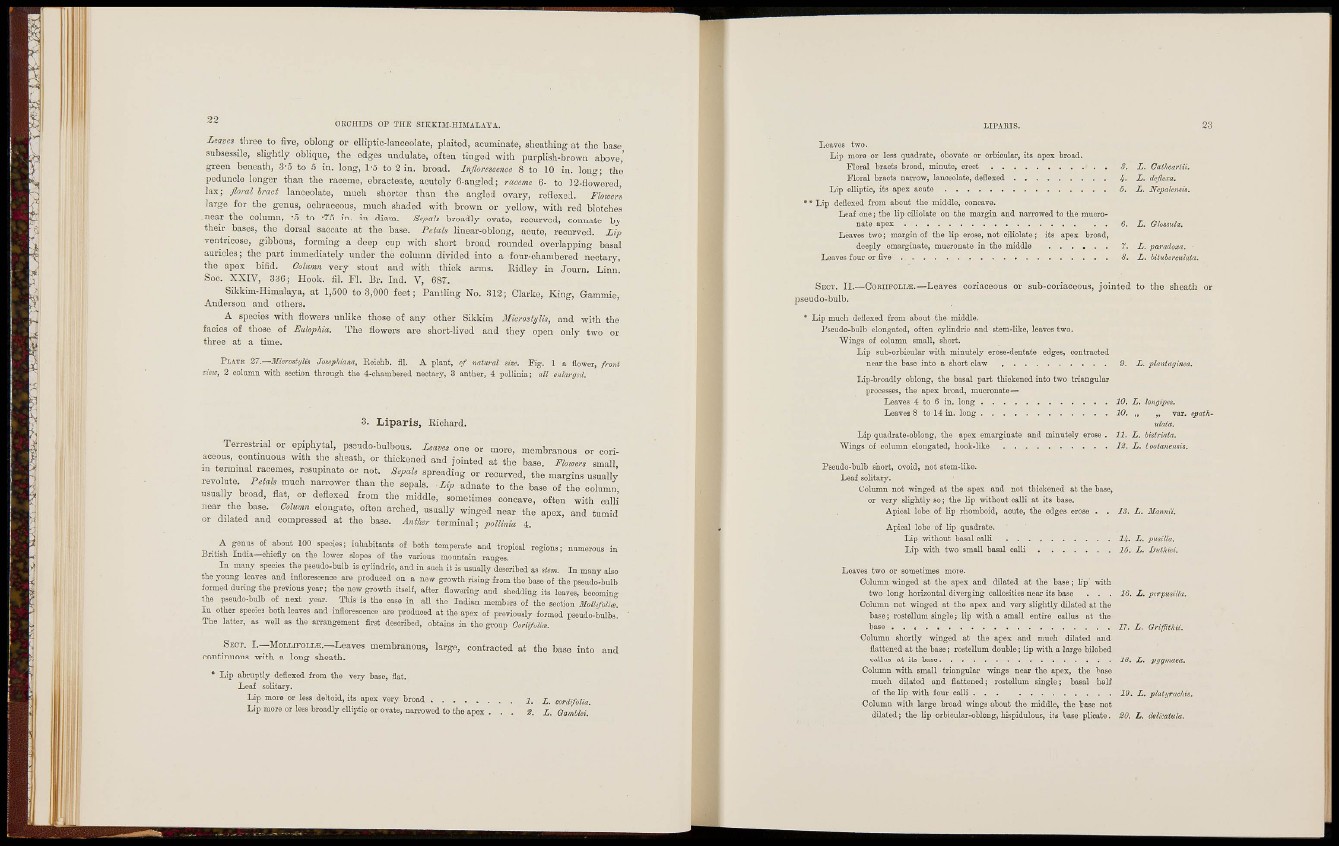
^ ORCHIDS OF THE SIKKIM-HIJIALATA.
tliree to five, oblong or elHptic-lanceolate, plaitod, acuminate, sheathing at tho base
subsessile, slightly oblique, the edges undulate, oftea tingad with purplish-brown above,'
green beneath, 3-5 to 5 in. long, 1-5 to 2 in. broad. Injlomccnco 8 to 10 in. long; tha
peduncle longer than the raceme, ebracfceate, acutely 6-augled; raceme 6- to 12-flowcred,
l a x ; Jloral bract lanceolate, much shorter than the anglod oraiy, roflexcd. Flowers
large for the genus, ochraceous, much shaded with brown or yellow, with red blotches
near the column, -5 to -75 in. in diam. Sepals broadly oyate, recurved, connate by
their bases, the dorsal saccate at the base. Potáis linoar-oblong, acute, recurved. Lip
ventricose, gibbous, forming a deep cup with short broad rounded overlapping basal
auricles; the part immediately under the column divided into a four-chambered nectary,
t h e apex biiid. Column very stout and with thick arms. Ridley in Journ. Linn
Soc. XXIV, 3a6; Hook. fil. Fl. Br. Ind. V, 687.
Sikkim-Himalaya, at 1,500 to 3,000 feet; Pantling No. 312; Clarke, King, Gammie,
Anderson and others.
A spccies with flowers unlike those of any otlier Sikkitn MicroitnUs, and with the
facies of those of Eulophia. The flowers are short-lived and they open only two or
three at a time.
PLATE 27.--MiaroatijUs Joiephiam, Roiohb. fll. A plant, of natural site. Fig. 1 a flower, front
view, 2 column witli section through the 4-chauibered nectary, 3 anther, 4 pollinia; all enlarged.
3. L ipa r i s , Richard.
Terrestria l or epiphytal, p.eudo-bulbous. one or more, membranous or coriaceous,
continuous with the sheath, or thickened and jointed at the base. Flomr. small
m termmal racemes, resupmate or not. sp r e a d i n g or recurved, the margins usually
revo ute much n anwe r than the sepals. Zy. adnate to the base of the column,
usually bvoad, flat, or deflexed from the middle, sometimes concave, often with calH
near the base. Column elongate, often arched, usaally winged near the apex, and tumid
or dilated and compressed at the base. Antkar terminal; pollinia 4.
A genu3 of about 100 speoiea; iahabitants of both temperate and tropical regions- numerous in
British India-cMeSy on the lower slopes of the various mountain ranges.
I n many species the pseudo-bulb is cylindrio, and in such it is usually described as stem. In many also
theyouug leaves and inaoreseence are produced on a ne!7 growth rising from the base of the pseudo-bulb
formed during the previous year; the new growth itself, after flowering and shedding its leaves, becoming
the pseudo-bulb of next year. This is the ease in all the Indian members of the section Molhfolue
In other speciea both leaves and inflorescence axe produced at the apes of previously formed pseudo-bulbs
The latter, as weU as the arrangement first described, obtams in the group Goriifolim.
S e c t , I.—Molufoli/'e.—Leaves •
continuous with a long sheath.
large, contracted at the base into and
• Lip abruptly defleicd from the very base, flat.
Leaf solitary.
Lip more or less deltoid, its apes very broad
Lip more or less broadly elliptic or ovate, narrowed to the apex .
1. L. eordifolia.
L. Qamblei.
LIPABIS. 23
Leaves two.
Lip more or less quadrate, obovate or orbicular, its apes brood.
Floral bracts broad, minute, erect S. L. Catkoariii.
Floral bracts nnn'ow, lanceolate, deflexed L. dcflexa.
Lip elliptic, its apes aoute 5. L. ITepalemis.
• • Lip deflexed from about the middle, concave.
Leaf oue; the lip ciholate on the margin and narrowed to the mucronate
apes Q. L. Glossula.
Leaves two; margin of the lip erose, not oiliolate; its apes broad,
deeply emarginate, mucronate in the middle 7. L. parndoxa. •
Leaves four or five 8. L. bituberculala.
Sect. IL—Coriifoli^.—Leaves coriaceous or sub-coriaccous, jointed to the sheath or
pseudo-bulb.
• Lip mucli deflexed from about the middle.
Pseudo-bulb elongated, often cylindrio and stem-like, leaves two.
"Wings of colomn small, short.
Lip sub-orbicular with minutely erose-dentate edges, contracted
near the base into a short claw 9. L. planlaginea.
Lip-broadly oblong, the basal part thickened into two triangular
processes, the apex broad, mucronate—
Leaves 4 to 6 in. long 10. L. longipos.
Leaves 8 to 14 in. long 10. „ „ var. spntkvlata.
Lip quadrate-obloDg, the apex emarginate and minutely erose . 11. L. bktriata.
Wings of column elongated, hook-like 12. L. lootanenm.
Pseudo-bulb short, ovoid, not stem-like.
Leaf solitary.
Column not winged at the apes and not thickened at the base,
or very slightly so; the Hp without calli at its base.
Apical lobe of hp rhomboid, acute, the edges erose . . 13. L. Manmi.
Apical lobe of lip quadrate.
Lip without basal colli Ik. L. pusilli..
Lip with two small basal caUi 16, L. hutkki.
Loaves two or sometimes move.
Colunm winged at the apes and dilated at the base; lip' with
two long horizontal diverging callosities near its base . . . 16. L. pcrpmilla.
Column not winged at the apes and very slightly dilated at the
base; rostellum single j lip with a small entire callus at the
base 17. L. Griffithii.
Columa shortly winged at the apes and much dilated and
flattened at the base; rostellum double; lip with a large bilobed
callus at its base 18. L. pygmuea.
Column with small triangular wings near the apex, the base
much dilated and flattened; rostellum single; basal half
of (he hp with four calli 19. L. platyrdchis.
Column with large broad wings about the middle, the base not
dilated; the lip orbicular-oblong, hispidulous, ita lase plicate. SO. L. c